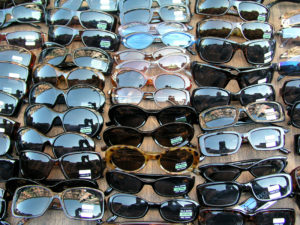More than just a fashion statement
 It’s July! What does that mean? Happy UV Safety month!
It’s July! What does that mean? Happy UV Safety month!
Most people know about the importance of using sunscreen to protect their skin from the sun’s harmful UV (ultraviolet) rays, but what about protection for your eyes?
Although most of us choose the perfect shades based on appearance, comfort, and price, style must take a backseat to safety. If we choose sunglasses on style alone, we are overlooking what eye doctors (ophthalmologists) consider the most important factor: protection from ultraviolet rays and significant eye damage.
I don’t think most people realize that unprotected sun exposure can significantly harm our eyes. According to the American Academy of Ophthalmology:
- Excessive amounts of UV over a short interval can lead to “sunburn on the eye,” which results in pain, blurry vision, or even temporary blindness (photokeratitis).
- Prolonged exposure can lead to vision loss, such as cataracts and age-related macular degeneration.
- Premature aging of the skin around the eyes
- Skin cancer around the eyes
The effects of UV radiation on the eyes are cumulative. Damage today leads to vision problems later, which is why eye doctors recommend that we should protect our eyes starting at a young age. Regardless of the brand name or price, the most important feature to look for in a pair of sunglasses is how well they protect your eyes from UV rays.
The American Academy of Ophthalmology recommends the following tips when shopping for your next pair of shades:
Read the labels: Choose sunglasses that have labels that say they block 99% to 100% of UV rays. You should stick with sunglasses labeled “UV400 protection,” which refers to wavelength (nanometers) and means that they block all UV light from entering your eyes.
Choose the right style: Ideally, your sunglasses should be large enough to cover the sides of your eyes to shield them from stray light. Wraparound sunglasses can be helpful in blocking harmful UV light from coming in through the sides and back of the frame.
Consider the tint of the sunglasses: UV protection is not related to how dark the lens is. A clear lens with no tint and 100% UV protection is better for your eyes than dark, heavily tinted sunglasses without UV protection. In reality, dark lenses without proper UV protection are actually worse for your eyes than not wearing glasses at all.
Since the dark tint causes you’re pupils to become dilated, this results in exposing your eyes to more harmful UV light. Sunglasses tinted green, amber, red or gray may offer the same protection as dark lenses.
Buyer beware: Buying expensive designer sunglasses or (knockoff designer wannabe’s from a sidewalk vendor) without UV protection offer no protection and instead will make your eyes suffer. Sunglasses do not have to be expensive to protect your eyes and they can often be found at the local drugstore.
WEAR a wide-brimmed hat or cap if you’ll be out in the sun for a prolonged period or if you will be working or being active outdoors.
NEVER stare directly at the sun. It can permanently scar the retina, which is the area at the back of the eye.
Remember to wear sunglasses even if it’s cloudy. Rays can pass through haze and thin clouds. It is especially important to wear sunglasses in the early afternoon and at higher altitudes where UV light is more intense.
The American Academy of Pediatrics advises that your eyes should be checked by an ophthalmologist at least every two years after the age of 5 or more often if recommended. You don’t have to give up style, just remember to choose sunglasses with UV400 protection! This is the best way to maintain eye health and protect your vision!
-Shaoleen
Links:

